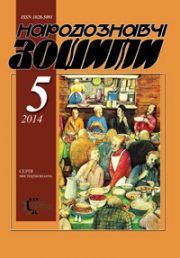The Ethnology Notebooks. 2023. № 2 (170), 413—418
UDK75:7.041.5 (477.87)”1950/1999″
DOI https://doi.org/10.15407/nz2023.02.413
IVANYTSKA Tetiana
- ORCID ID: https://orcid.org/0000-0003-4932-0956
- Postgraduate student of the Lviv National Academy of Arts,
- 38, Kubiiovycha Street, 79011, Lviv, Ukraine,
- Teacher of the College of Arts A. Erdeli,
- of the Transcarpathian Academy of Arts,
- 37,Voloshina st., 88000, Uzhgorod, Ukraine,
- Contacts: e-mail: tetyana02@gmail.com
Abstract. The article examines the portrait genre of Transcarpathian painting of the second half of the 20th century. Varieties of the pictorial portrait as a special form of self-identification of the author’s «I» of the artist, which includes moral, philosophical, social, aesthetic aspects, are considered. The portrait works of the followers of the Transcarpathian art school — A. Kotsky, V. Mykyta, I. Ilko, F. Seman and others — were analyzed. Attention is focused on the absolutization of the subjective principle of the artist’s creativity and ways of forming his author’s «I». It was established that the substantial facet of the author’s «I» is structured by the following factors: family-related ties, socio-professional relations, spiritual self-immersion, Christian identity, ethnic-cultural factor. The visual expression of these aspects largely determines the main concept of the portraitist’s creativity, thereby reflecting the uniqueness of his worldview and artistic thinking.
The relevance of this article lies in the identification of potential models and ways of creatively creating the image of the artist’s «I» and determining their characteristic features. Due to the fact that in art there is a desire for a holistic understanding of a person, it seems relevant to investigate the problematic field of pictorial portraiture as a specific form of self-identification of the author.
The aim of the study is based on the analysis of the portrait works of Transcarpathian painters, it is possible to identify and characterize the artist’s personality, his essential «I» influences the reflection of the image of a person in the portrait genre. Outline the main models of the artist’s self-identification, reveal the importance of personal preferences in artistic forms, portrait styles.
The object of the study is the portrait work of Zakarpattia painters of the second half of the 20th century, and the subject is the characteristic features of the self-identification models of the artist’s «I» and their interpretation by pictorial and compositional means.
As a result of the research, it was proved that the Transcarpathian pictorial portrait of the second half of the 20th century demonstrates the multifaceted nature of the author’s «I» of the artist, manifested through family-related, religious-ideological, social-professional, ethnic-cultural and self-portrait identification. It was determined that the portrait artist is the personification, carrier and translator of the national cultural heritage, as well as an innovator who brings new trends characteristic of the second half of the 20th century.
Keywords: pictorial portrait, self-identification, author’s «I», self-portrait, Christian identity, ethnic and cultural affiliation.
Received 25.02.2023
REFERENCES:
- Sokolova , E.T. (2015). Clinical Psychology of the loss of I. Мoskva: Smyisl [in Russian].
- Smit, Entoni D., & Taraschuk, P. (1994). National identity. Kyiv: Osnovy [in Ukrainian].
- Krivtsun, O.A. (2005). The creative process as a potentiation of the artist’s multidimensional self. Metamorphoses of the creative self of the artist (Pp. 14—32). Moskva [in Russian].
- Delez, Zh. (2002). Criticism and clinic. SPb. [in Russian].
- Litvinova, O.V. (2016). The problem of studying family identity as a component of the self-concept of an individual. Nauk. visnyk KhDU, 3 (1), 130—135 [in Ukrainian]
- Kuzma, Borys. (2016). Our friend Volodymyr Mykyta. Obrazotvorche mystetstvo, 2, 28—31[in Ukrainian].
- Zahrebelnyi, Ihor. (2013). «Christian identity» as a consequence of the de-essentialization of religion. Retrieved from: https://www.religion.in.ua/main/21384-xristiyanska-identichnist-yak-naslidok-deesencializaciyi-religiyi.html (access date: 14.12.2022).
- Fedynyshynets, M. (2009, February 19—25). Rustic essence: the work of Ivan Ilko is like a bridge between Manaylo and Kotska. Staryi zamok. Palanok (P. 20) [in Ukrainian].
- Ruban, V. (1977). Ukrainian Soviet portrait painting (Pp. 95—97). Kyiv: Mystetstvo [in Ukrainian].
- Kagan, M.S., & Lohtina, M.P. (1987). The aesthetic significance of the transformation of interpersonal relationships in the artist’s self-expression. Aesthetic culture in the conditions of STP (Pp. 72—79). Sverdlovsk [in Russian].





